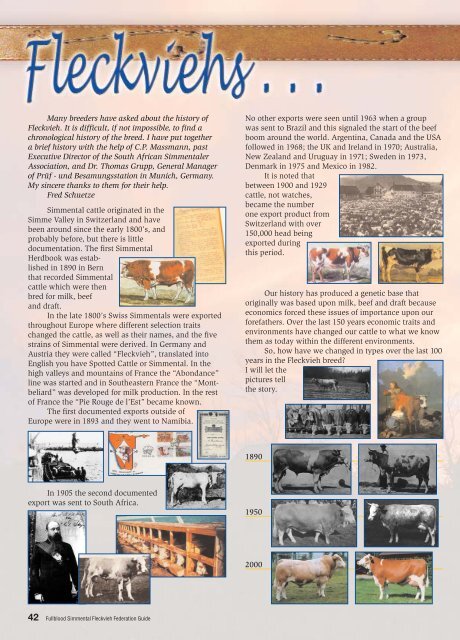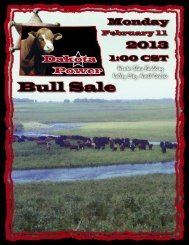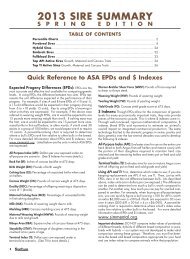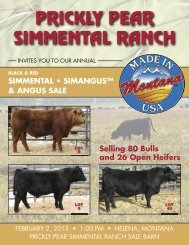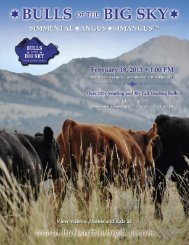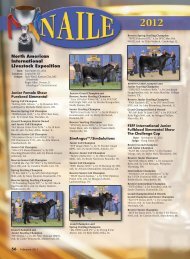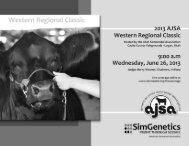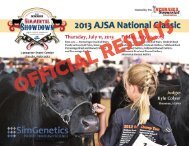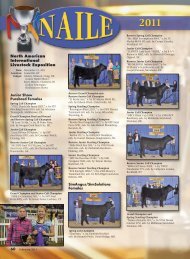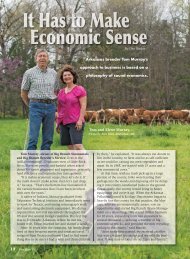Fleckvieh History 08 - American Simmental Association
Fleckvieh History 08 - American Simmental Association
Fleckvieh History 08 - American Simmental Association
Create successful ePaper yourself
Turn your PDF publications into a flip-book with our unique Google optimized e-Paper software.
Many breeders have asked about the history of<br />
<strong>Fleckvieh</strong>. It is difficult, if not impossible, to find a<br />
chronological history of the breed. I have put together<br />
a brief history with the help of C.P. Massmann, past<br />
Executive Director of the South African <strong>Simmental</strong>er<br />
<strong>Association</strong>, and Dr. Thomas Grupp, General Manager<br />
of Prüf - und Besamungsstation in Munich, Germany.<br />
My sincere thanks to them for their help.<br />
Fred Schuetze<br />
<strong>Simmental</strong> cattle originated in the<br />
Simme Valley in Switzerland and have<br />
been around since the early 1800’s, and<br />
probably before, but there is little<br />
documentation. The first <strong>Simmental</strong><br />
Herdbook was established<br />
in 1890 in Bern<br />
that recorded <strong>Simmental</strong><br />
cattle which were then<br />
bred for milk, beef<br />
and draft.<br />
In the late 1800’s Swiss <strong>Simmental</strong>s were exported<br />
throughout Europe where different selection traits<br />
changed the cattle, as well as their names, and the five<br />
strains of <strong>Simmental</strong> were derived. In Germany and<br />
Austria they were called “<strong>Fleckvieh</strong>”, translated into<br />
English you have Spotted Cattle or <strong>Simmental</strong>. In the<br />
high valleys and mountains of France the “Abondance”<br />
line was started and in Southeastern France the “Montbeliard”<br />
was developed for milk production. In the rest<br />
of France the “Pie Rouge de l’Est” became known.<br />
The first documented exports outside of<br />
Europe were in 1893 and they went to Namibia.<br />
No other exports were seen until 1963 when a group<br />
was sent to Brazil and this signaled the start of the beef<br />
boom around the world. Argentina, Canada and the USA<br />
followed in 1968; the UK and Ireland in 1970; Australia,<br />
New Zealand and Uruguay in 1971; Sweden in 1973,<br />
Denmark in 1975 and Mexico in 1982.<br />
It is noted that<br />
between 1900 and 1929<br />
cattle, not watches,<br />
became the number<br />
one export product from<br />
Switzerland with over<br />
150,000 head being<br />
exported during<br />
this period.<br />
Our history has produced a genetic base that<br />
originally was based upon milk, beef and draft because<br />
economics forced these issues of importance upon our<br />
forefathers. Over the last 150 years economic traits and<br />
environments have changed our cattle to what we know<br />
them as today within the different environments.<br />
So, how have we changed in types over the last 100<br />
years in the <strong>Fleckvieh</strong> breed<br />
I will let the<br />
pictures tell<br />
the story.<br />
1890<br />
In 1905 the second documented<br />
export was sent to South Africa.<br />
1950<br />
2000<br />
42 Fullblood <strong>Simmental</strong> <strong>Fleckvieh</strong> Federation Guide
Now, where are we nearly a<br />
decade from the turn of the century<br />
In Europe, where milk is the<br />
driving force, <strong>Fleckvieh</strong> are still dual<br />
purpose cattle and selection has<br />
maintained it to be a balanced<br />
breed, not selected for the extremes.<br />
Balanced, productive and<br />
highly efficient dual purpose cattle,<br />
suitable for the production of milk,<br />
beef, and beef by-products,that can<br />
be kept in all production systems around the world.<br />
<strong>Fleckvieh</strong> were imported to North America in 1968<br />
and started the pendulum genetic swing from the cattle<br />
of the 40’s and 50’s, that were just over three feet tall, to<br />
the large framed, narrow gutless wonders of the 70’s and<br />
80’s, and then on to a trend toward smaller framed, easy<br />
fleshing, thicker cattle with less milk to stay productive<br />
on pasture land throughout the US.<br />
40’s & 50’s<br />
70’s & 80’s<br />
Summary was created in 1971 by <strong>American</strong> <strong>Simmental</strong><br />
<strong>Association</strong>, and they continue to lead the field in the<br />
pursuit of perfection.<br />
The acceptance of <strong>Fleckvieh</strong> cattle globally is because<br />
of their economic advantages and their adaptability.<br />
Crossbreeding with Dairy Breeds<br />
<strong>Fleckvieh</strong><br />
2006<br />
<strong>Fleckvieh</strong> x Jersey<br />
<strong>Fleckvieh</strong> x Holstein<br />
World<br />
Congress<br />
1978 2006<br />
What is the future of the <strong>Fleckvieh</strong> Breed<br />
Crossing with dairy breeds<br />
Performance testing of <strong>Simmental</strong><br />
cattle started in the early years and<br />
weights were a requirement for<br />
registration. The first <strong>Simmental</strong> Sire<br />
Crossing with beef breeds<br />
Dual Purpose<br />
Fullblood <strong>Simmental</strong> <strong>Fleckvieh</strong> Federation Guide 43
As one travels around the world it is easy to see<br />
why <strong>Fleckvieh</strong> have maintained such a presence in the<br />
beef cattle industry. The numbers of <strong>Simmental</strong> cattle,<br />
in the world population, is second only to Zebu. And,<br />
again, the reason is adaptability and proven genetics<br />
that are a century old.<br />
In some countries the color has changed and type<br />
has been modified to meet environmental and market<br />
demands, but the genetic base of <strong>Fleckvieh</strong> continues<br />
to provide the base for superior performance.<br />
Meeting the needs of the cattle industry<br />
Over the last 150 years <strong>Fleckvieh</strong>s have changed<br />
also to meet the demands imposed upon them by the<br />
environment and the market place. In some countries<br />
smaller framed, easy fleshing and calving with less milk<br />
and higher carcass quality are issues, along with color.<br />
While in others countries, size and color are not an issue<br />
and more milk is desirable.<br />
The key issue here is that within the <strong>Fleckvieh</strong><br />
gene pool there are genetics available to produce the<br />
type of cattle needed, and, as long as <strong>Fleckvieh</strong> breeders<br />
don’t go to extremes, the cattle will survive as they have<br />
done for the last 1 1/2 centuries.<br />
South Africa<br />
South America<br />
Current <strong>Fleckvieh</strong> Types<br />
Europe<br />
Australia and New Zealand<br />
USA<br />
Moderate Size — Easy Calving — With Depth Of Rib<br />
Good Udders With Adequate Milk — Natural Thickness<br />
Sound Feet And Legs — Carcass Quality<br />
44 Fullblood <strong>Simmental</strong> <strong>Fleckvieh</strong> Federation Guide


